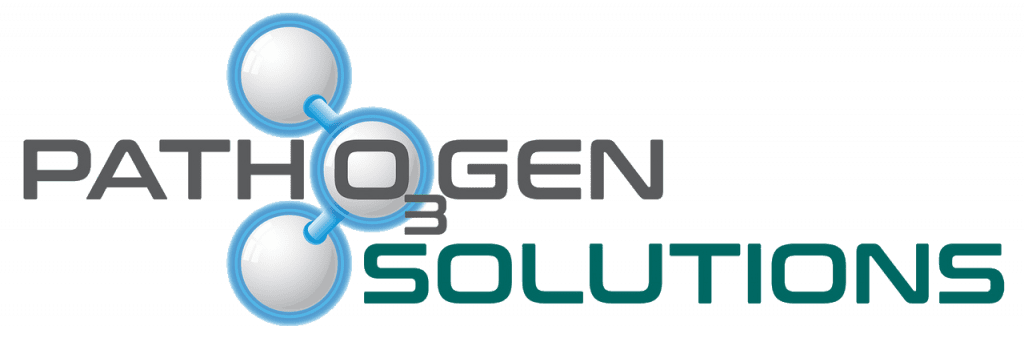How Does Ozone Disinfection Work?

Ozone isn’t just the smell of fresh rain — it may be the next generation sanitizer thanks to ozone disinfection.
And in the time of Covid-19, other diseases could be on the horizon. Bacterial superbugs lurking around the corner. The next virus could be waiting in the wings. Now is a more important time than ever to explore ozone disinfecting for your business.
With dozens, hundreds, or even thousands of customers coming in your business per day, it’s hard to tell where they’ve been and what they could be bringing in with them. Taking a few extra steps could be the difference between preventing and proliferating disease transmission.
Let’s break it down a little.
What Is Ozone?
Ozone consists of three oxygen molecules bonded together. Oxygen, element 8 on the periodic table, has an unusual atomic configuration.
First, we’ll break down a little bit of what you might remember from high school chemistry. Elements are defined by the number of neutrons, protons, and electrons. Electrons from different elements can bond together.
Oxygen exhibits high electronegativity. This means it wants to take on electrons that come near it, easily bonding to other atoms.
Sometimes, this comes in the form of water — two hydrogen atoms bonding to a single oxygen molecule.
But oxygen can also bond to itself. We breathe in O2, or two oxygen molecules bonded together. Ozone is O3. But the unique nature of the latter enables ozone disinfecting to work.
What Is Ozone Disinfection?
Because of the highly reactive nature of oxygen, ozone is often used in cleaning chemicals. Oxides — chemicals containing oxygen — are frequently found in cleaning chemicals.
But ozone disinfection is swiftly gaining popularity as a cleaning agent. Some medical uses are still under investigation. Ozone in well-ventilated spaces is a vital source of disinfection. It bonds to and breaks down viruses, bacteria, and other harmful pathogens.
Ozone disinfection is sometimes used in wastewater treatment. The treatment plants inject a stream of oxygen-bearing gasses into the water. They then discharge 6 to 20 kilovolts, creating a rapid disinfecting effect.
Disinfecting with ozone eliminates E. coli, Salmonella, Norovirus, Hep A, and other diseases. These could cause widespread disaster if they contaminated the water supply.
Lab research backs up the use of ozone disinfection against SARS-CoV-2, or Covid-19. Ozone could be as good a line of defense as alcohol, bleach, and other disinfectants.
There’s other research backing up these claims. An NIH-funded study found that ozone had the potential to eliminate 99 percent of the virus when used as a disinfectant. When paired with UVC light, the results are even more impressive.
What About UVC Light As a Disinfectant?
Behind the counter at CVS, you may see things like cell phone disinfectors. These use an ultraviolet lightbulb to attack cell walls in germs.
Think of it this way: the hazards of ultraviolet light are why you have to wear sunscreen every day. It can wreak havoc on your skin and even lead to melanoma.
But this same effect makes it a good (and safe) disinfectant. It works best when paired with other disinfectants.
Why is this?
According to the Food and Drug Administration, UV light works best on water, air, and non-porous surfaces.
Its usefulness has been demonstrated against the SARS Coronavirus, more commonly known as SARS. Covid-19 is a relative, but research seems to point to UV light being less effective on this variant.
There are many hazards associated with the improper use of UVC light. Contact with skin can damage it. It can degrade many common materials. And an improperly disposed bulb can cause mercury contamination.
How Can I Use Ozone Disinfection in My Business?
Pathogens can come in many forms from countless sources. For instance, it can ride in on our skin or we can breathe them in. But we can also bring them in as hitchhikers on our clothes and shoes.
Disinfecting with ozone helps eliminate bacteria and viruses.
Viruses can live on surfaces for varying periods of time. A letter to the New England Journal of Medicine indicated that the Covid-19 virus can live on a few surfaces for hours or days at a time, including:
- Three hours in the air
- Four hours on copper, a metal known for its anti-microbial properties
- 24 hours on cardboard
- Two to three days on stainless steel and plastic
In other words, on common objects, it can last a long time. Bruce Lee, a health contributor at Forbes, suggests that coronavirus may have a similar life on clothes as it does on cardboard.
This question has sparked a lot of debate, without a clear answer. For instance, the texture of the material and its rigidity may matter. WebMD Health News indicates it may live more easily on hard surfaces than soft ones. But that’s where shoes — which need a rigid structure to be effective – come in.
Should I Use Ozone Disinfection on My Shoes?
Given the body of research on ozone disinfection and Covid-19, it’s a good idea to stop the coronavirus on a surface where it may be spreading as it comes into your business, especially as the delta variant ramps up and you may be opening your door to more customers.
That’s why a UVC Light Shoe Sanitizer could be the tool you need in your business. It uses a combination of ozone disinfection and ultraviolet light to create a one-two punch in combatting the novel coronavirus.
The UVC Light Shoe Sanitizer was tested on a variety of pathogens, including antibiotic-resistant Staphylococcus aureus and Klebsiella pneumonia, food-borne contaminants like E. coli, and Clostridioides difficile, a deadly pathogen sometimes referred to as C. diff. In all cases, it eliminated most of the viruses and bacteria.
All these pathogens are dangerous to humans, and having a UVC Light shoe sanitizer is a great line of defense in preventing diseases from creeping into your business, especially as shoes can blur the line between soft/rigid and porous/nonporous surfaces.
How Does The UVC Light Shoe Sanitizer Work?
The UVC Light Shoe Sanitizer combines the power of UV light and ozone disinfection to sanitize your shoes against pathogens in a matter of seconds.
In the lab, seven different deadly pathogens were subjected to the device in 6, 8, and 10 second increments. At six seconds, between 98 and 99 percent of all the studied diseases — both viral and bacteria — were disinfected. But using the device for 10 seconds eliminated at least 99.9 percent of each pathogen – and all the way up to 99.999% of Candida Auris on shoes.
Think about it: how long would it take you to use a harsh disinfectant on your shoes? At minimum, a few minutes to get those kind of results, per pair of shoe. Neither you nor your customers have time for that, each time you enter.
Studies already show that several bacteria are commonly found on shoes. This includes:
- E. coli
- MRSA
- Klebsiella pneumoniae
But in under 10 seconds, the UVC Light Shoe Sanitizer can eliminate bacteria and viruses, providing a simple and quick way to stop the spread of pathogens as you come in the door. Just spend 10 seconds on the scanner and voila!
Why Is The UVC Light Shoe Sanitizer Important?
While SARS-CoV-2 is primarily transmissible by air, it’s often environmentally transmitted indoors. This means that with inefficient HVAC systems, it has the potential to spread around when brought into an environment.
While this mostly comes from coughing and sneezing, there are other ways to introduce it into an environment, and it’s important to sanitize surfaces across your house in order to stop transmission in its tracks.
And while we think of countertops, all-around sanitation is important.
In a business environment, customers will be coming and going, bringing in a number of materials from a number of environments. You don’t know where they’ve been. We have hand sanitizer placed at the front of many businesses — why not take the next step and sanitize shoes too?
And it’s important to think beyond our current moment: diseases can come and spread from multiple vectors, and preventing the next pandemic will be important.
Viruses mutate. New diseases emerge. It’s important to be ready.
Get The UVC Light Shoe Sanitizer Now
We want to prevent the next pandemic from happening, so a UVC Light Shoe Sanitizer can payout in the long run, whether it’s as the delta variant spreads and other variants could be waiting in the wings, or when cold and flu season next strikes.
The UVC Light Shoe Sanitizer is a quick and effective step to make sure you’re proactively protecting yourself and your customers as much as you can.
It’s safe to use, effective against disease with proven results. Because it requires no extra staffing, it can be a matter of asking a customer to step on it a few extra seconds before entering your business setting.
You owe it to your customers. You owe it to your staff. And you owe it to yourself — keep your business safe, keep your business sanitized.
Be part of the solution.

